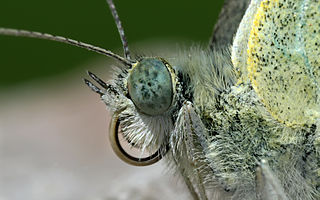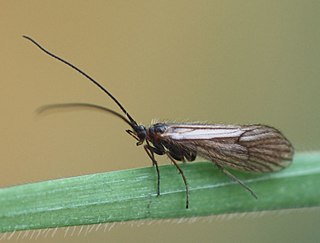
A pupa is the life stage of some insects undergoing transformation between immature and mature stages. Insects that go through a pupal stage are holometabolous: they go through four distinct stages in their life cycle, the stages thereof being egg, larva, pupa, and imago. The processes of entering and completing the pupal stage are controlled by the insect's hormones, especially juvenile hormone, prothoracicotropic hormone, and ecdysone. The act of becoming a pupa is called pupation, and the act of emerging from the pupal case is called eclosion or emergence.

Aquatic insects or water insects live some portion of their life cycle in the water. They feed in the same ways as other insects. Some diving insects, such as predatory diving beetles, can hunt for food underwater where land-living insects cannot compete.

The caddisflies, or order Trichoptera, are a group of insects with aquatic larvae and terrestrial adults. There are approximately 14,500 described species, most of which can be divided into the suborders Integripalpia and Annulipalpia on the basis of the adult mouthparts. Integripalpian larvae construct a portable casing to protect themselves as they move around looking for food, while annulipalpian larvae make themselves a fixed retreat in which they remain, waiting for food to come to them. The affinities of the small third suborder Spicipalpia are unclear, and molecular analysis suggests it may not be monophyletic. Also called sedge-flies or rail-flies, the adults are small moth-like insects with two pairs of hairy membranous wings. They are closely related to the Lepidoptera which have scales on their wings; the two orders together form the superorder Amphiesmenoptera.

Limnephilidae is a family of caddisflies with about 100 genera. They belong to the main lineage of case-constructing caddisflies, the Integripalpia or tube-case caddisflies. The Limnephilidae is one of the most species-rich Trichoptera families of northern temperate regions, but only a few are known from tropical areas and the Southern Hemisphere. For this reason they are often known as northern caddisflies.

Helicopsychidae are a family of Trichoptera. The name refers to the helix shaped larval cases and they should not be confused with Limnephilidae which sometimes inhabit the snail shells. Their shells range from 6–8 millimetres (0.24–0.31 in) and are crafted from mineral grains. Their typical habitat is in slow-flowing water in ditches. Helicopsychidae larvae have a comb-like anal hook. Helicopsychidae is divided into two extant genera, Rakiura and Helicopsyche, and two fossil genera Electrohelicopsyche and Palaeohelicopsyche. The family contains more than 270 species and are present on all major faunal regions.

The Hydropsychidae are a family-level taxon consisting of net-spinning caddisflies. Hydropsychids are common among much of the world's streams, and a few species occupy the shorelines of freshwater lakes. Larvae of the hydropsychids construct nets at the open ends of their dwellings which are responsible for their "net-spinning caddisfly" common name.

The Ecnomidae are a family of caddisflies comprising 9 genera with a total of 375 species.

The Psychomyiidae are a family of tube-making caddisflies. Members of this family are typically very similar to polycentropodids, most of them can be differentiated by the spur formula is 2-4-4, thyridial cell short, absence of the forewing fork I, and hindwing forks I and IV. Male genitalia has elongate preanal appendages, and reduced tergum IX. The larvae differ by the submental sclerites separated, foretrochantin broad, and the pupal mandible apex whip-like. Larvae construct long silken galleries.
Smicrideinae is one of five subfamilies in the family Hydropsychidae of net-spinning caddisflies.
The Glossosomatidae are a family of the class Insecta and order Trichoptera.The family contains 23 genera in three subfamilies. In the US alone, there are 76 spp. in 6 different genera.

Agriotypinae is a subfamily of ichneumonid parasitoid wasps found in the Palaearctic region. This subfamily contains only one genus, Agriotypus. The known species are aquatic idiobiont ectoparasitoids of Trichoptera pupae.

Eriogaster lanestris, commonly known as the small eggar, is a moth of the family Lasiocampidae that is found across the Palearctic. Unlike many other members of the Lasiocampidae, the small eggar is a social insect. Historically, only eusocial insects like ants, bees, and termites were thought to exhibit complex social organization and communication systems. However, research since the late 20th century has found that E. lanestris, among a number of other phylogenetically related moth and butterfly species, demonstrates social behaviors as well. Larvae spend nearly their entire development in colonies of about 200 individuals, and this grouped social structure offers a number of benefits, from thermoregulation to increased foraging success.
Calliphora latifrons is a species of blue bottle fly.

The external morphology of Lepidoptera is the physiological structure of the bodies of insects belonging to the order Lepidoptera, also known as butterflies and moths. Lepidoptera are distinguished from other orders by the presence of scales on the external parts of the body and appendages, especially the wings. Butterflies and moths vary in size from microlepidoptera only a few millimetres long, to a wingspan of many inches such as the Atlas moth. Comprising over 160,000 described species, the Lepidoptera possess variations of the basic body structure which has evolved to gain advantages in adaptation and distribution.
Rakiura is a genus of Trichoptera (caddisfly). The genus contains only one species, Rakiura vernale, which is endemic to New Zealand. Rakiura vernale represents the most basal taxon within the Helicopsychidae.

Enoicyla pusilla also known as the land caddis and the terrestrial caddis is a species of caddisfly in the family Limnephilidae. The genus Enoicyla is unique among caddisflies because the larvae are terrestrial, living in leaf litter.

Dicosmoecus is a genus of october caddis in the family Limnephilidae. There are about six described species in Dicosmoecus.
The Society for Freshwater Science (SFS) is an international scientific society whose members study freshwater ecosystems and ecosystems at the interface between aquatic and terrestrial habitats.

Chloronia is a genus of dobsonflies in the family Corydalidae.

Stenoperla prasina is a species of stonefly belonging to the family Eustheniidae. This species is endemic to New Zealand and is classified as "Not Threatened" under the New Zealand Threat Classification System. It is found on the North, South and Stewart Island / Rakiura Islands as well as on Little Barrier Island. Although adults of this species are most often coloured bright green, this species can be coloured yellow. This species inhabits clean, cold, running streams and rivers with stony bottoms within native bush. It is a known indicator of water quality. The larvae eat plant detritus and other aquatic insects while the adult insects feed on sooty mould fungi as well as other plant matter. The adults of this species are a known food source for New Zealand long tailed bats. Adults have been dissected and have been found to have been carrying Nematomorpha and trematode parasites. The New Zealand Department of Conservation classifies this species as "Not Threatened". In 2022 a specimen of this species was the 5 millionth specimen to be digitised in the Natural History Museum, London collection.














